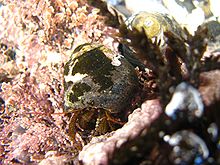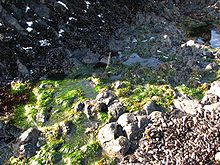Pagurus hirsutiusculus
From marinelife1011
Contents |
Description
Physical Characteristics
The hairy hermit crab (Pagurus hirsutiusculus) is the most common species of hermit crab in the Puget Sound region.[1] Like other hermit crabs, it inhabits empty shells of other organisms. [1]
Hairy hermit crabs are typically smaller than 19 mm, but can grow up to 3 cm.[1][2] This species of hermit crab is distinguished by a white band near the end of the walking legs.[1][2] Hairy hermit crabs typically are olive green or black in color[2]; however, their color varies with the age of the crab.[1] The antennae are grayish-brown with distinct white bands.[1][2]
Range and Habitat
Hairy hermit crabs are widely found on the coasts of the North Pacific. Its range includes northern Japan, Siberia, the Bering Sea, and the west coast of North America, and is very common on Puget Sound beaches.[3] They are found mainly in the upper and middle intertidal areas.[1]
Behavior
Hermit crabs are well known for inhabiting the shells of other species, which serve as protection for the crab.[4] The hairy hermit crab prefers a light and small shell.[1]
Role of Shells in Lifecycle
Shells play an extremely important role in the life cycle of hermit crabs. Hermit crabs must finds new shells both when the existing shell becomes worn out due to abrasion and when the crab becomes too large for its existing shell.[5] Failing to find a new shell can inhibit the growth of the crab.[5]
Shell Selection
Hermit crabs are able to locate a possible shell at a distance and then explore the shell to determine if it is suitable, making use of visual, chemical, and physical cues.[6] They are selective in choosing shells, and may choose a shell only if it is from a particular species or has particular physical or chemical characteristics.[6][7] The chelar setae are used both as physical receptors and in detecting calcium, allowing the hermit crab to differentiate shells from rocks.[6] However, hermit crabs will occupy shells of a variety of species, depending on the size of the crab and the shell.[5] The hairy hermit crab occupies shells from around thirty species of gastropods.[5]
Feeding
The hairy hermit crab is a scavenger and feeds mainly on decayed matter.[2] This serves as the main source of nutrients in most hermit crabs, but they will also feed on small pieces of animals and plants.[2][5]
Reproduction and Life History
A female will brood a clutch of eggs for two to three weeks, with the size of the clutch being affected by the size and weight of the female's shell.[8] Males are often much larger than females in a mating pair.[5] After hatching from the egg, hermits crabs pass through five larval stages—four zoea stages and the glaucothoe stage.[3] The hermit crabs progresses from hatching to the glaucothoe stage about 35 days.[3]
Ecology
Hermit crabs influence intertidal ecosystems by inhabiting shells that would otherwise be abandoned, keeping the shells from being buried in sediment and allowing them to be used as a substrate for other organisms.[4] In some cases, the unoccupied shells become buried quickly enough that the only available hard substrate is shells inhabited by hermit crabs.[5]
Evolution
There are over 800 species in the superfamily Paguroidea, the hermit crabs.[4] Hermits crabs are a part of the decapod crustaceans, which also includes true crabs, lobsters, and shrimp.[9] Other common crustaceans are krill and barnacles.





